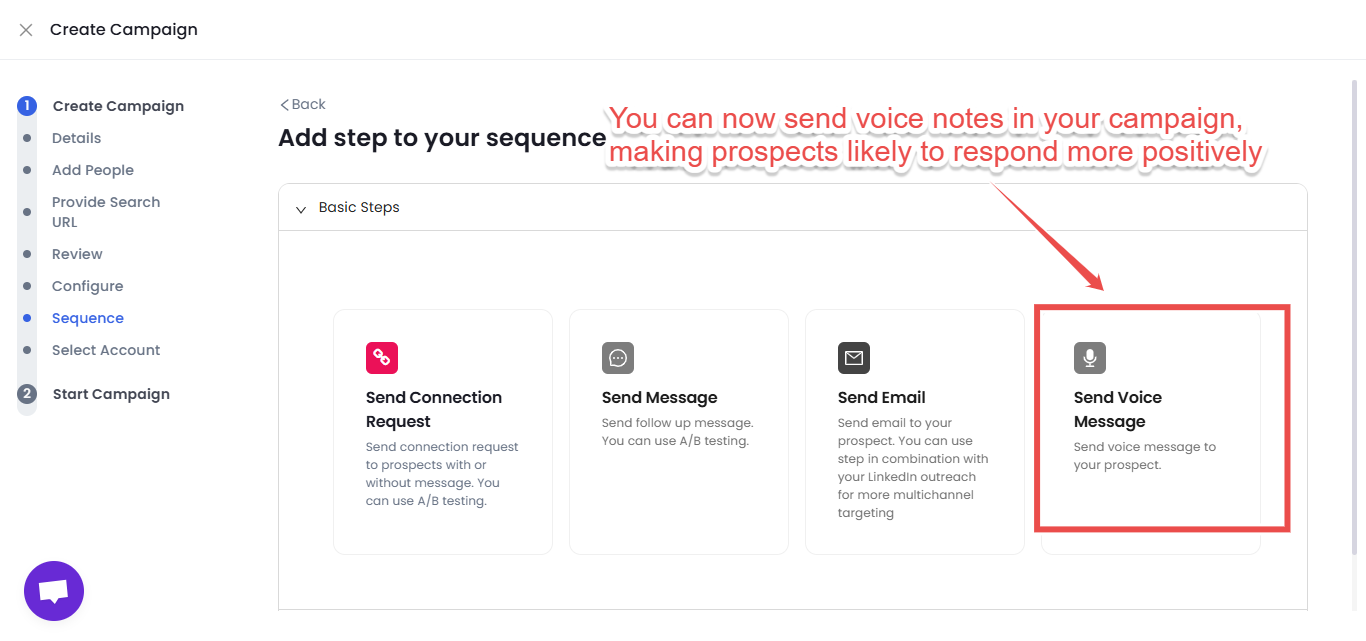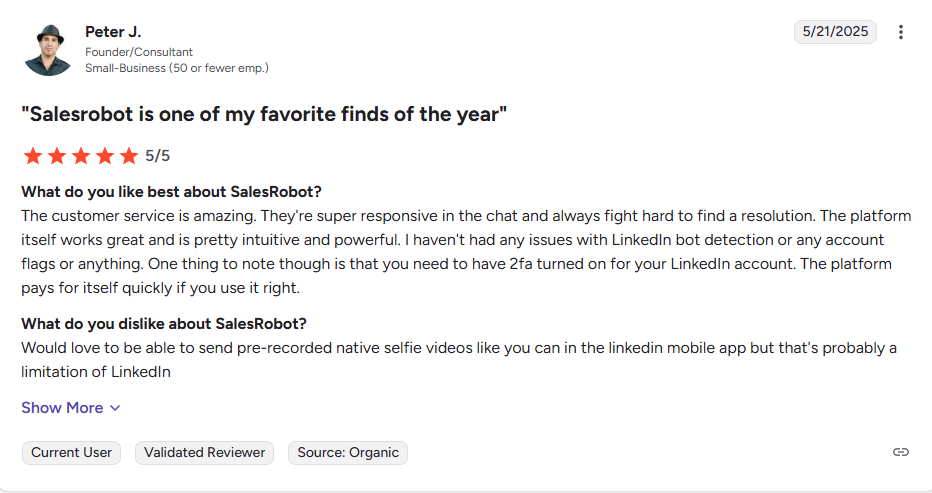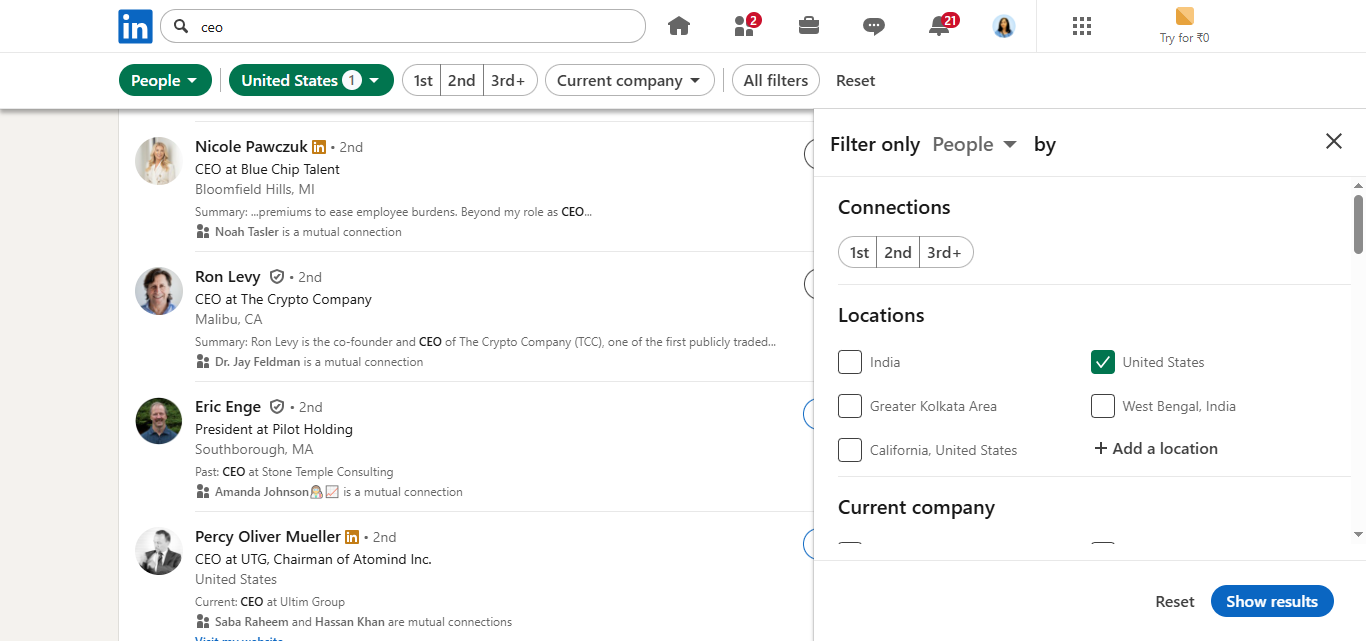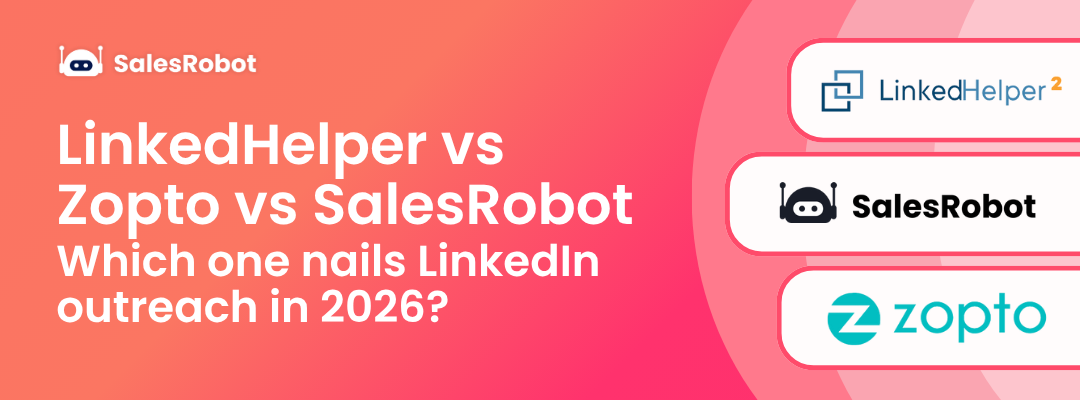This blog is for you…
If you want to grow your business via LinkedIn.
But you have no idea where to begin.
“Why,” you ask?
Well, only because (humble brag incoming…)
Because in the last 5 years, we scaled SalesRobot to six figures in revenue, all via LinkedIn inbound and outbound. We have serviced 4000+ users.
Because let’s face it- cold emails get 2% response rates. LinkedIn messages? 15-25%.
Even more if you know how to do it right.
While everyone else is fighting spam filters and unsubscribes, LinkedIn users are actively looking to connect, buy, and grow their businesses.
It's not just another social platform—it's where B2B deals actually happen.
And today, I am going to share everything about it.
But first, remember that building a high-converting LinkedIn sales funnel isn't about spamming connection requests or posting generic content.
And this guide shows you exactly how to build both inbound and outbound B2B sales funnels on LinkedIn that actually work.
So here’s what's in the menu today:
We’ll talk about “What is a B2B Sales Funnel?”
Learn about the “6 stages of B2B Sales Funnel,”
Check out “How to build an Outbound B2B Sales Funnel on LinkedIn with Examples”
Discover “How to build an Inbound B2B Sales Funnel on LinkedIn also with Examples”
Then we’ll chat about “Why should we use LinkedIn for a B2B Sales Funnel?”
And lastly, figure out “How to automate LinkedIn outreach”
Sounds exciting?
Let’s jump right in!

What is a B2B Sales Funnel?
At its heart, a B2B sales funnel is the step-by-step process that guides potential customers from
- Making them aware of their pain points,
- Acknowledging that there is a solution for their problem in the market,
- Make sure you provide one of the solutions,
- and then make them take the big leap of partnering with you.

But when we go into more detail, a B2B sales funnel has 6 steps, so let’s take a closer look at that.
6 Stages of the B2B Sales Funnel
The process often involves identifying potential leads, sending personalized connection requests, and following up, all of which can be time-consuming and prone to inconsistencies.
Recognizing these challenges is the first step toward optimizing your sales approach.
By understanding the stages of the B2B sales funnel, you can pinpoint areas where manual efforts may fall short and explore strategies to enhance efficiency and effectiveness.
1. Awareness
First things first, you need to get on your prospects' radar.
At this stage, potential customers realize they have a problem or need.
They might not be searching for solutions yet, but they're open to information.
Your goal is to grab their attention and introduce your solution as a helpful resource.
How to do it:
- Create valuable content:
Write blog posts, guides, and articles that address common pain points in your industry. The important thing is to have a unique PoV and not just make content for the sake of making content.
For example, we at SalesRobot believe that cold emails and cold calls are dying and LinkedIn is the best way to get clients. So all of our content is from that PoV. - Leverage social media channels like LinkedIn:
Share insights and industry news, and engage in conversations where your prospects are active.
For example, Cody warms up his prospect list by linking and commenting on their posts to get on their radar.
- Invest in SEO:
Optimize your content so it ranks well on search engines, making it easier for prospects to find you when they start their research.

Alex, for example, invests a lot in SEO, social media marketing, and cold outbound lead generation.
2. Interest
Now that you've got their attention, it's time to pique their interest.
Prospects are beginning to explore solutions and are curious about what you offer. This is your chance to engage them deeper.
How to do it:
- Offer educational resources:
Provide eBooks, whitepapers, and webinars that delve deeper into how to solve their challenges.
- Implement email marketing:
Capture their contact information and send them personalized content that aligns with their interests. Keep nurturing.
In fact, Jeremy sent around thirty thousand cold emails in a day, and guess what, it actually paid off.
- Engage through interactive content:
Use quizzes, assessments, or calculators that help them understand their needs better and how your solution fits in.

3. Consideration
Alright, they're interested! Now, they're weighing their options.
Prospects are evaluating different solutions to determine which best fits their needs.
How to do it:
- Showcase case studies and testimonials:
Demonstrate how your product or service has successfully helped others in similar situations.
- Offer free trials or demos:
Let them experience your solution firsthand to see its value.
- Provide detailed product information:
Be transparent about features, benefits, and pricing to help them make an informed decision.

4. Intent
They're leaning towards making a purchase.
Prospects have shown a clear interest in your solution and may have reached out for more specifics.
How to do it:
- Personalize your approach:
Tailor your communications to address their specific needs and concerns.
- Present customized proposals:
Offer solutions that align with their business objectives and budget.
- Highlight your unique value proposition:
Emphasize what sets you apart from competitors and why you're the best choice.
5. Evaluation
Decision time! They're doing a final comparison before committing.
Prospects are scrutinizing every detail to ensure they're making the right choice.
How to do it:
- Be responsive and transparent:
Address any last-minute questions or objections promptly and honestly.
- Provide additional assurances:
Share guarantees, support options, and onboarding processes to ease their concerns.
- Facilitate discussions with current clients:
Allow them to hear directly from satisfied customers about their experiences.
6. Purchase
Congratulations! They've decided to go with your solution. But the journey doesn't end here; it's crucial to ensure a smooth transition.
How to do it:
- Streamline the purchasing process:
Make contracts, payments, and other formalities as straightforward as possible.
- Offer comprehensive onboarding:
Provide training and resources to help them get the most out of your product or service.
- Maintain ongoing support:
Continue to be a resource for them, ensuring their satisfaction and fostering a long-term relationship.
Navigating these stages thoughtfully can transform prospects into loyal customers.
Remember, it's all about building relationships and providing value every step of the way. Keep it genuine, and you'll see your efforts pay off!
How to Build an Outbound B2B Sales Funnel on LinkedIn
Building an effective outbound B2B sales funnel on LinkedIn involves a strategic approach to identify, engage, and convert potential clients.
Here are the stages to help you establish a robust outbound b2b sales funnel:

1. Identify - Know who you're talking to
No outreach yet. Just research.
You need to know who your ideal customers are. Not just job titles.
We’re talking industry, company size, problems they’re facing, and even what tools they’re using.
Use analytics platforms and data-driven insights to curate a list of individuals or businesses that match your ideal customer profile.
Tools like LinkedIn Sales Navigator are considered to make this way easier.
2. Generate - Build a list that doesn’t suck
Now that you know who to go after, it's time to generate leads.
Create personalized and impactful messages that directly address your audience’s specific challenges and what they’re looking to achieve.
This could mean:
- Pulling emails from tools like Apollo, ZoomInfo, or Clay
- Enriching profiles to make sure you’ve got updated info
- Segmenting by priority so you’re not treating everyone the same
At the same time, you can look into Sales Navigators Advanced filters for the same

3. Connect - Start the convo like a human
When you're reaching out on LinkedIn or email, the goal is simple: start a genuine conversation.
Jorge, in fact, had a very successful campaign because he reached out to people with mutual connections and a warm connection request.
Mention something specific. Be curious. Keep it short. Most people don’t reply because outreach feels cold and cookie-cutter.
You want yours to feel like it came from a real person (because it did).
Engage with your prospects through strategic outbound channels such as phone calls, emails, social media DMs, or even traditional mail.
Here’s how you do it

Example:
“Hey [First Name], I saw your team is growing fast. Congrats! Curious if you’re currently exploring ways to scale outbound without burning out your SDRs?”
4. Meetings - Move the convo to your turf
Once the connection happens, your goal is to book a meeting. But it’s gotta feel like the natural next step.
- Share a case study or relevant insight
- Ask questions that show you understand their challenges
- Suggest a quick 15-minute call, not a demo, not a pitch, just a convo
The prospect should feel he is in control; this way, they’ll have low pressure. And will allow them to share everything with you.
Coordinate a discovery call or meeting with those who show promise to further explore how your solution can benefit them.
That’s how you land meetings.
5. Close- Show the ROI, not just the features
Now that they’ve seen the value, they’re considering the move.
This is where your proposal, demo, or pitch deck needs to shine.
Confidently ask for the commitment, finalize terms, and take care of the paperwork to officially close the sale.
Focus on:
- Outcomes, not just tools
- Social proof and real results
- Clear next steps and pricing
And above all, listen more than you talk.
6. Follow-up
Stay connected with clients after the sale to ensure satisfaction, provide support, and introduce new solutions when relevant.
When outbound is done right, closing doesn’t feel pushy. It feels like a solution is falling into place.
It’s about personalizing, connecting, and solving real problems.
Examples of Outbound B2B Sales Funnels
Crafting an effective outbound B2B sales funnel on LinkedIn can significantly boost your lead generation and conversion rates.
Let me explain now how this works for us at SalesRobot.
Identifying and Generating
You can use Sales Navigator’s advanced filters to generate such lists

👉 When we have our list, we simply run a campaign in SalesRobot with that list.

It’s super easy to set up.
- Once you sign up for the free trial, log in to SalesRobot.
- Then click on Campaigns and create a new campaign

- Next click on “I’m an advanced user” and proceed to name your campaign.
- Now, you have 9 different options to add prospects from

- Add your link from the method that works for you, and click on “Configure Settings.”

- Now, configure your settings and proceed to add your message sequence.
- We prefer to add 3-5 personalized steps depending on who we’re trying to target, with a 2-4 day gap in between.
- Select “From Scratch” here.


- You’ll see several “Advanced Steps” other than adding messages and emails.
Steps such as “like” and “comment” will help you warm up gradually to 2nd or a 3rd degree connection on LinkedIn.
Once you’ve added the messages, click on “Save” and “Start Campaign.”
We also integrate different channels to boost our outreach, increase the response rates and eventually book meetings.
We use LinkedIn, Facebook, and Email.
And, of course, keeping an eye on everything is important.
How to Build an Inbound B2B Sales Funnel on LinkedIn
Building an inbound B2B sales funnel on LinkedIn involves attracting potential clients by providing valuable content and nurturing relationships.
This approach positions your company as a trusted resource, encouraging prospects to engage with your offerings.
Here are the stages to create an effective inbound B2B sales funnel on LinkedIn:
4 Stages of an Inbound B2B Sales Funnel
Alright, let's break this down in the simplest, most human way possible.
You’re here to build a killer inbound B2B sales funnel on LinkedIn, right? Cool.
There are four key stages to this funnel: Attract, Convert, Close, and Delight.

Let’s walk through each stage and what it looks like on LinkedIn.
1. Attract
This is where strangers turn into curious visitors. On LinkedIn, you’re not chasing leads, you’re giving them a reason to find you.
Here’s what works:
- SEO-optimized posts
- Articles that solve real pain points
- Thoughtful content that adds value
Instead of waving your product in someone’s face, you're handing out insights, hot takes, or tips that your target audience genuinely finds useful. You’re earning attention, not forcing it.
2. Convert
So someone sees your post or reads your blog. Great. But now what?
You need to give them an easy way to take the next step.
On LinkedIn, this could be:
- Clicking on a CTA in your post
- Filling a form for a lead magnet (like a whitepaper or a checklist)
- Landing on a page that’s built to convert
If they’re digging what you offer, don’t let them wander off. Guide them into your world with a clear, helpful next move.
3. Close
You’ve got the lead. Nice. But it doesn’t stop there.
This is the part where a lot of people mess up, they go silent or hit with a hard sell right away. Nope.
Instead, follow up smartly. Use LinkedIn messages, share relevant case studies, maybe even connect on a short video call.
Tools like CRMs and automated sequences help here, but the real win? Showing up like a real human who understands their business.
The close happens when trust builds. Not before.
This is where SalesRobot can help you.
Our hyper-personalized messaging, ability to send voice notes at scale, and our AI Appointment Setter that actually carries on conversations for you will definitely make your job easier.

4. Delight
Alright, the deal is done. But the funnel isn’t.
Now’s your moment to make them promoters: people who talk about you without being asked to.
- Ask for reviews

- Tag them in LinkedIn success posts
- Get feedback with surveys
Happy customers are your loudest marketing tool. Plus, they bring referrals.
Sounds doable, right? It's all about creating real value at every stage. If your funnel feels like a conversation instead of a pitch, you're doing it right.
Examples of Inbound B2B Sales Funnels
Crafting an effective inbound B2B sales funnel involves attracting potential clients through valuable content and nurturing them towards a purchase decision.
Let's explore 2 distinct examples:
1. LinkedIn Content Funnel
Objective: Utilize blog content to guide potential clients through the buyer's journey.
Process:
Alright, let’s get into the real heart of how an inbound sales funnel actually works: the good ol' TOFU, MOFU, BOFU structure.
Yes, those sound like fancy marketing acronyms, but once you get the hang of them, they make your funnel feel super logical and way more human.
Let’s break it down and chat about how each one plays out, especially on platforms like LinkedIn or your blog.
Top of the Funnel (TOFU):
This is where you're simply getting on your audience’s radar.
People don’t know you yet.
They're not looking to buy.
They’re probably just scrolling, clicking around,
Or Googling something they’re stuck on.
Your job here? Show up and be helpful.
- Post blogs that solve common problems your audience faces
- Share trends, stats, or "things no one is talking about" in your industry
- Put out short LinkedIn posts that spark a “hmm, that’s interesting” reaction
Example: Let’s say you sell B2B lead gen software. Instead of shouting “Buy now!”, post something like:
“Struggling with getting replies on LinkedIn? Here’s what worked for us (and tripled our response rate).”
Like with the post below

See what that does? It starts generates traffic.
Middle of the Funnel (MOFU):
Now the person knows you exist. They’ve clicked something. Maybe they liked your vibe. But they’re still not ready to buy.
This is where you show them your chops. Time to build trust.
- Drop in-depth guides that show how to solve a problem
- Share real case studies, not the boring kind, but the "here’s exactly what we did and what happened" type
- Webinars, downloadable checklists, cheat sheets, anything that says, “I get your problem, and I know how to fix it”
Think of it like dating. You’re not proposing yet, just showing that you're solid, consistent, and know what you’re talking about.
For example,

Compared to the TOFU post, this one dives deeper into the industry and tackles a specific problem your MOFU audience is already dealing with.
On LinkedIn it is a post where you break down a recent campaign you ran for a client, numbers, process, and results.
Bottom of the Funnel (BOFU): This is it. The lead is warm. They’ve read your posts, maybe downloaded your guide, maybe even connected with you. Now they’re thinking, “Hmm, should I reach out?”
Your job now?
Make that “yes” easy.
- Share side-by-side product comparisons
- Put out customer testimonials or short video clips of happy clients
- Have a clear, friendly CTA like “Want to see how this would work for your team? Let’s chat.”
At this stage, it’s all about removing doubt.
Be human, be transparent, and make the next step feel low-pressure but valuable.
TOFU gets you seen.
MOFU builds trust.
BOFU seals the deal.
Make posts that highlight what you do and use CTAs.
For example,

2. RB2B Funnel
Objective: Utilize RB2B's person-level website visitor identification to enhance inbound.
RB2B helps identify anonymous website visitors and provides details like their names, job titles, and LinkedIn profile URL.
This means you can reach out to people who have already shown interest in your content, making your outreach more effective.
Here’s how we use RB2B:
We get about 22K website traffic every month thanks to our blogs and LinkedIn content.
RB2B then helps us unmask anonymous US website visitor.
But wait this is where it gets interesting.
Instead of figuring who reached out to we have created an automation that lets us automatically reach to people visiting our website.
And done via SalesRobot.The entire process is fully automated, saving you time while boosting your outreach.
Together, these tools help you not only attract visitors but also convert them into valuable leads, streamlining your sales process and boosting your business growth.
Why use LinkedIn for B2B Sales Funnel?
So, you're building a B2B sales funnel, and you’ve got tons of platforms to choose from, email, cold calls, webinars, ads. So, why should LinkedIn be your go-to move?
Here’s the thing... LinkedIn is Disneyland for B2B.
Everyone you need to sell to is already right there.
Here are 5 reasons why LinkedIn is Your Best Approach To B2B Sales:
1. Your buyers are already hanging out there
You're not interrupting someone’s cat video scroll like on Instagram or TikTok. You’re actually reaching decision-makers who are thinking about growing their business.
VPs, founders, sales managers, marketers, they live on LinkedIn.
And they’re not just lurking either.
They’re reading, engaging, and connecting.
That means your funnel doesn’t have to scream for attention. Just show up with the right message at the right time.
2. Trust hits differently on LinkedIn
When someone sees a helpful post from you or a smart comment you left, that builds credibility without even selling.
This platform is built on human connections. You’re not just a brand, you're a real person they can DM, follow, and trust. That trust makes every step of your funnel easier.
3. It’s content and outreach in one place
You can write TOFU, MOFU, and BOFU all on LinkedIn.
We’ve talked about it already.
It’s like building an entire funnel without ever leaving one platform. Isn't that just... efficient and kinda genius?
4. Targeting is freakishly good
LinkedIn lets you filter by job title, industry, company size, location, tools used, and more.

That means you’re not wasting time talking to people who don’t need what you offer.
You’re laser-focused from Day 1.
5. It scales without losing the human touch
You can automate smartly with tools like SalesRobot, but still keep your outreach warm and personal.
So whether you’re doing manual outreach or running a whole sequence, LinkedIn makes it feel personal, not robotic.
And that’s why LinkedIn should be your B2B funnel playground.
It’s targeted. It’s trust-based. It’s where business is already happening.
Once you get the flow right, from connection request to customer, it’s game on. Want to build a funnel that actually feels natural on LinkedIn? Let’s do it.
How to automate LinkedIn Outreach
Finding your ideal customer profile (ICP), crafting the perfect message, and following up is a full-time job!
But it doesn’t really have to be if you use SalesRobot.
Here’s how:
1. Log in to SalesRobot and then create a new campaign
.jpeg)
2. Now, select “Create campaign using SalesGPT.”
.jpeg)
After that, SalesGPT will ask questions to generate detailed buyer profiles tailored to your business.
It will then analyze these profiles to find common challenges/pain points and suggest a customized series of messages.
.jpeg)
3. Now it will start creating the message sequence for you after you select any of the persona.
It will set up a connection request step to automate your connection requests.

4. Now, once the connection request is accepted, SalesGPT will start automating with the first follow-up after a connection request is accepted

5. If the first follow-up doesn’t get any response, SalesRobot will automate a second follow-up for a better resolution to get back a response.

7. Once the message sequence is created, you must paste the search URL from LinkedIn search or LinkedIn Sales Nav search.
Ex: Search for Founders/COO/CEO on LinkedIn and copy the URL as shown below
.jpeg)
4. Now paste it.
.jpeg)
And that’s it.
Congratulations! Your LinkedIn Outreach is now Automated.
CONCLUSION
Navigating the world of B2B sales on LinkedIn involves balancing both inbound and outbound strategies.
Inbound efforts focus on attracting prospects through valuable content and engagement, while outbound tactics involve proactive outreach to potential clients.
In this blog, we've explored the essentials of crafting both inbound and outbound B2B sales funnels on LinkedIn.
And also discussed strategies to attract, convert, close, and delight prospects through thoughtful content and engagement.
For more detailed insights:
- Learn how to create an effective Inbound Marketing Funnel on LinkedIn.
- Understand the nuances between Inbound vs Outbound Sales on LinkedIn.
- Discover LinkedIn Outreach Strategies to enhance your lead generation efforts.
By taking advantage of these strategies and utilizing tools like SalesRobot, you can optimize your LinkedIn approach for better engagement and higher conversion rates.
Managing these approaches manually can be time-consuming and complex.
This is where SalesRobot steps in.
Whether you're drawing leads in or reaching out directly, SalesRobot streamlines the process, allowing you to focus on building meaningful relationships and closing deals.
The companies winning on LinkedIn in 2025 aren't just posting more or messaging more people.
They're being more strategic, more human, and more valuable at every touchpoint.


